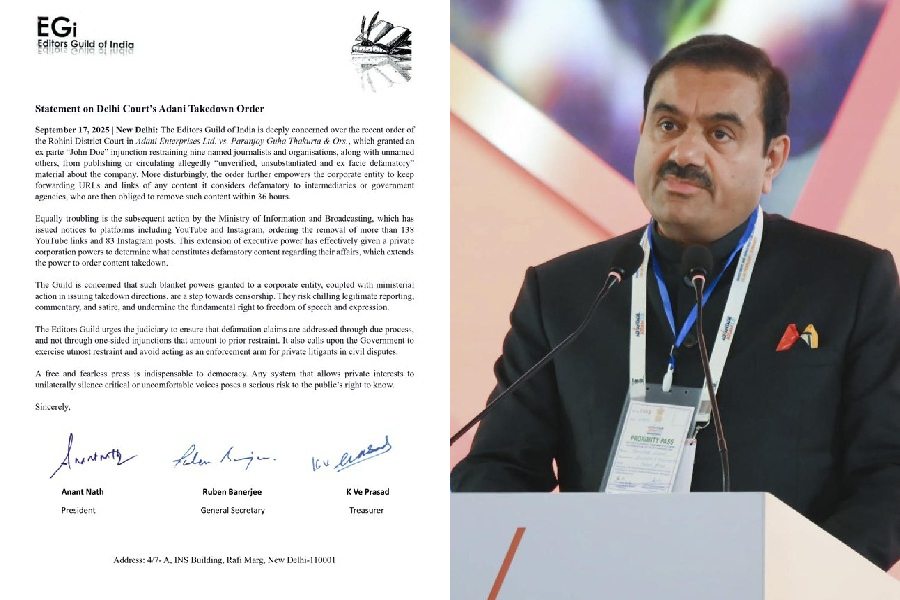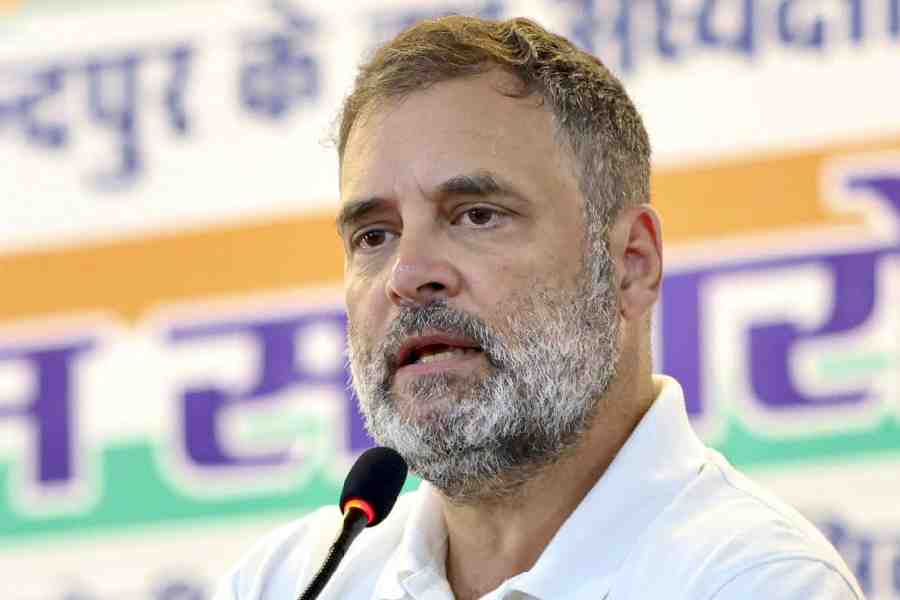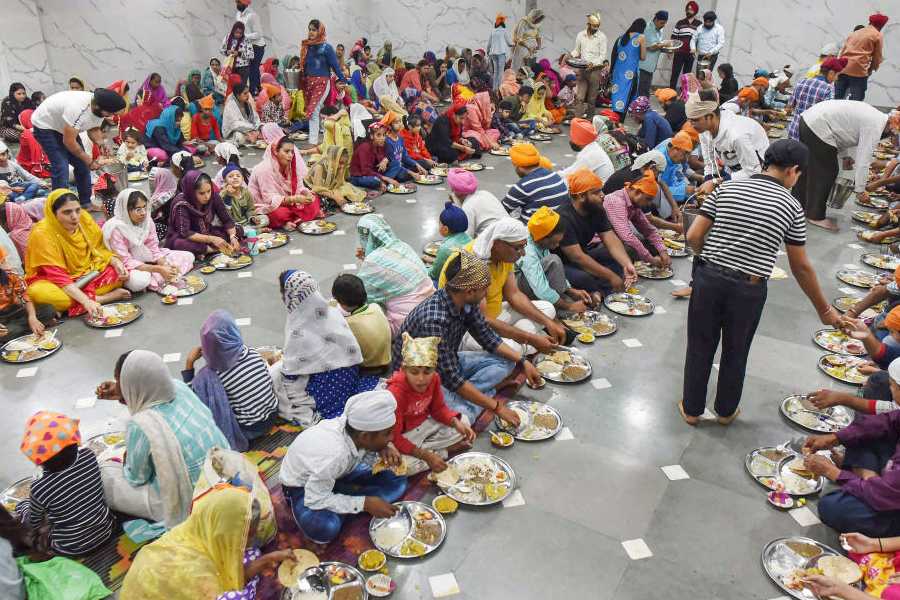 |
Kalpana Dasgupta, former librarian, on what the National Library must do and Swapan Chakravorty, director-general, on what the National Library is doing
Kalpana Dasgupta: I’ll tell you about some of the major roles I think the National Library should be playing, considering what other national libraries do.
First, the National Library is meant to function as a depository library as well as a repository.
Swapan Chakravorty: And I will try and answer as to how we are carrying out the functions that Kalpanadi points out or why we are unable to do some of them.
Yes, the National Library functions as a depository as well as a permanent repository. The first means that under the Delivery of Books and Newspapers (Public Libraries) Act, 1954, or the DB Act, the National Library is entitled to receive a copy of every publication brought out anywhere in the country. And repository means we have to keep all that we receive and make them available to users.
Here we are facing two problems. One, compliance. Other than the National Library, every publication must also be deposited at the public libraries in Delhi, Mumbai and Chennai. So, if your book is priced at Rs 2,000, that’s Rs 8,000 gone, plus postage. And the fine for non-compliance (under the Press and Registration of Books Act)? Minimal.
Also, today, much of the material is born-digital. On March 25, 2011, I convened a stakeholders’ meeting here. We spent an entire day in workshop. It was a battle. The publishers did not want to budge but we said no, you have to give the born-digital material.
By the end of this decade, 50 per cent of monographs will be born-digital. We didn’t have the infrastructure in place to react to the changes in technology and this is what I have been trying to address. We have the software and hardware in place, we now have a directory of electronic resources. National Library will be able to now take technological migrations and shocks for the next 10 years.
The other problem is the diversity of the material. Because in India, we have 1,600-plus languages that are spoken as mother tongue by more than 10 lakh people. This is just the sarkari count. It is easier to run the British Library, let me tell you. It is not so easy to run the National Library of India if it’s a depository library.
In terms of a repository, we have created enough space to house physical material for quite some years to come. Here the problem is in functioning as a digital repository, particularly for Indian- language material.
KDG: However, a national library should not be used as a public library. It should be a reference library, a library of last resort on subject “India” and it should be the repository of everything published in India. But here, you can borrow from the lending section of the National Library.
SC: The National Library as a library of last resort was the recommendation of many, including, I think, the Jha Commission. But there is a historical legacy of this library. It descends linearly from the Calcutta Public Library, then the amalgamation of the Secretariat libraries, then the so-called Imperial Library and finally to its present form as the National Library of India. So, the lending section remained, which national libraries usually don’t have. Also, the National Library came into being at a time when India was pretty poor, so we have always kept books that students may need. A Class IX student will definitely not spend a whole day at the British Library solving sums. But these things happen at the National Library because there are many people who can’t afford books and we have to fulfil that role. It’s not the failure of the National Library, it is the failure of the public library movement in India. From the village to the block to the district level, we need libraries to service people who can’t afford books. We need libraries that will have community services. For example, some schools can double as libraries in the evenings. Why not?
These creative ideas have not been explored. The National Mission on Libraries, thankfully, wants us to do that. Whether they will be done in practice or not I don’t know but I am involved with the recommendatory exercise, which is why the Mission was set up recently.
KDG: If the Mission can upgrade public libraries, which hopefully it will, and revive the concept of para libraries, which was very much there in Calcutta and other presidency cities, the lending load on the National Library will reduce. One of the major organisations that will implement the Mission’s work is the Raja Rammohun Roy Library Foundation (RRRLF). According to the Constitution of India, public library is a state subject. Therefore the RRRLF was set up in 1972 because the Centre can’t directly intervene for the development of the public library movement in the country.
SC: The foundation plays an in-between role connecting the Centre and the state. Reaching funds and books to the public libraries is part of the RRRLF’s work.
KDG: A national library should act as the apex of the entire library system of the country. This system can be divided into four major types: a) national library; b) academic library system, which comprises the university, college and school libraries; c) public library system d) special libraries like institutional libraries, research libraries etc.
The National Library should collaborate with all these libraries. By that I mean collaboration through services, like the Library of Congress does in the US, or what the British Library does. The material should be so well-serviced that it can be made available from a distance.
Now, the whole concept of librarianship has made a shift from collection-orientation to access-orientation.
SC: The services that Kalpanadi is talking about are the things I have focused on. You expect these services of a national library. Not just foreigners, people from all over India should be able to come and see the material here, with a minimum loss of time.
And I am happy to report that in spite of the imperfections of work culture, the services have improved. Not because we have improved as a people but because technology is on our side.
I am very happy that during my time, access has become a very important issue. But remote access is not something that we are able to give because of certain problems with the commercial database providers.
The providers have many terms and conditions, such as user licences, and prices go up accordingly.
Secondly, granting total access comes with its own set of problems, which I am unable to spell out. Some are political jhamelas. Also, total access is something that nationally-funded libraries like the British Library are not keen on giving.
We try to give conditional access. Here you will have no problem in accessing anything that we have at the moment. Very soon members will be able to access almost our entire digital collection.
If you go to our website and click on “Rare books and manuscripts”, you will have the entire modern manuscript list. So you know what is the call number before you come here. Even if you are coming from Norway, you have to spend just one hour here.
As far as giving remote access to digital resources is concerned, the problem is, an electronic resource is a commercial database that we either acquire through annual subscription or on a perpetual access basis. And there are download clauses, which if you overstep, your licence may be cancelled.
KDG: Another major thing that a national library should do is collaborate with other national libraries of the world in a very big way — collaborative efforts, training programmes, exchange of information. A national library should collaborate also with international institutions, for example the International Federation of Library Associations and Institutions (IFLA), based in The Hague. You see, if you are the national library of a country, and a country as large and as important as India, you can’t remain as a regional public library, you must have global visibility.
SC: Yes, I totally agree. Just some days back I received a letter from the United Nations saying ‘we are now accepting most material in soft copies so please give us the necessary passwords to access your materially digitally’. We’ve just made digital passwords, digital signatures etc. But
because of the focus on other matters I am not sure when the DB Act will be placed in Parliament [for amendment].
The National Library’s presence is required worldwide. It’s an area where we have suffered badly. The government of India should be sensitive to this particular need in the cultural institutions sector. Because we have many, many bureaucratic hurdles to cross even to go to a neighbouring country. The academic is less hassled in this respect.
Also, when Kalpanadi worked here, the question was to build the National Library’s profile, make it visible throughout the world. My mandate is different — to put the National Library back on the cultural map of India, from where it has fallen off! I try to do some event or activity at the National Library every other day, just so that there is a constant interest in the National Library.
KDG: Next, the National Library should make standards — bibliographic standards, training standards, etc — for the library system of the country. The large libraries of the world do this. They work with organisations that prepare guidelines and standards. I’ll give you an example. When I went to the Library of Congress, they showed me how the Australian National Library had prepared country-specific subject headings, to be incorporated in the Library of Congress’ subject headings list.
Our National Library should take up a project to prepare an India-specific list of subject headings, which can be internationalised through the Library of Congress and IFLA.
Nowadays, so much material is getting digitised in India. But are they being done following guidelines? That is another function the National Library must carry out.
Then virtual library... it’s the “in” thing now. But what is it? How will it be set up? Where are the guidelines? The ministry of culture could be involved in this, now that the National Mission has come up. And with the Mission in place, the role of the National Library has become even more important. The National Library should be the main library interacting with the Mission.
SC: The National Library should play a leading role, I agree. But there has been some division of responsibility. INB or the Indian National Bibliography is being produced by the Central Reference Library. They have a set of standards for transliterations etc.
Coming to standardisation, earlier you looked up the catalogue of a library. Now when you are digitising material, you also need metadata, which will give you technical details including equipment, specifications and date. So, those will also have to be standardised.
Now, because of disaster management, the metadata is supposed to be kept in a separate kind of a container. Academic libraries usually keep their metadata in Cloud or mirror servers. But if we want to do that for the National Library, there are people who might object, saying that these steps would increase risks. Our ICT Advisory Committee is looking into the problem seriously.
Standardisation of the metadata is also extremely important because otherwise we will not be able to exchange anything with anybody. That’s why I want to go for VAF or Virtual Authority File. If you go to the Authority File, then you can integrate your national library with other national libraries without going into a bureaucratic thicket.
The National Mission on Libraries has a sub-working group on standardisation, where the National Library will play a part, the Central Reference Library will play a part and the members themselves will play a part. There is a growing movement in India now about Open Access software. The problem is National Library has not yet shifted to the Open Access system. I’ve shifted our operating system to Oracle. Oracle will support Linux but we have not shifted to Linux yet. Once we shift to Linux, and not Windows, we will be able to have Open Access system.
I have sought help from Subbiah Arunachalam, who is one of the leaders of the Open Access advocacy movement in India, about switching to Open Access.
KDG: Technological upgrade brings with it another function that a national library must look into — lifelong learning. This is a must, for librarians and information specialists, because technology is changing, the way of giving access is changing, user demands are changing, and all this is changing rather fast.
SC: In the National Mission, there is a working group for training and National Library is one of the five or six centres chosen. We also have in-house training programmes. I don’t want to depend on the National Informatics Centre (NIC) all the time. So I have sent two people to the SAARC Documentation Centre to get training. In fact, that’s one of the first things I did. I joined the National Library in April 2010, in June I created a new division here, called the HRD and training division.
What I found during those two months was that library training was treated as tourism. I have got all of them to come here and train now. No more travelling around in the name of training!
There are also user training programmes at the National Library where our vendors come and tell our staff how to use the materials they are supplying us with. A few months back I had 40 people of this library taught in the library how to use the software Virtua not just for cataloguing and classification but for entire library management.
What does the National Library mean to you? Tell ttmetro@abpmail.com










